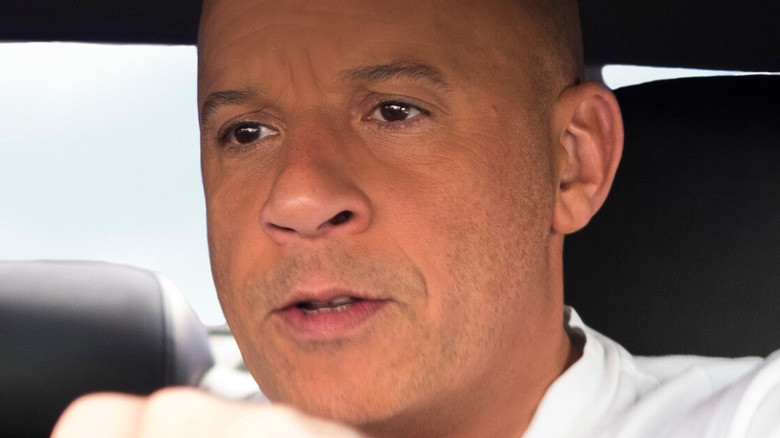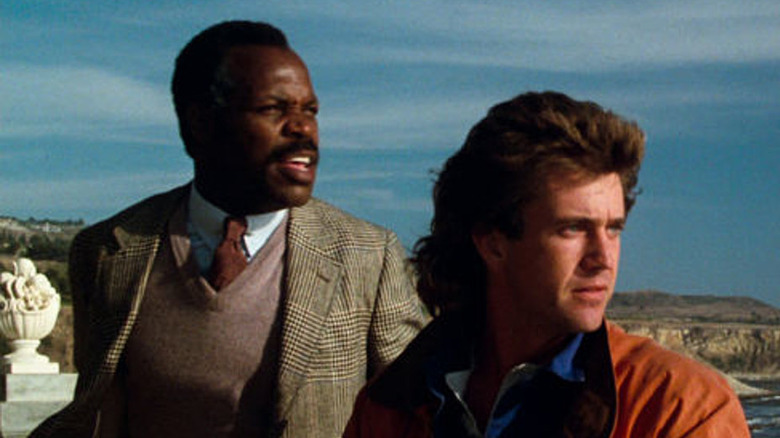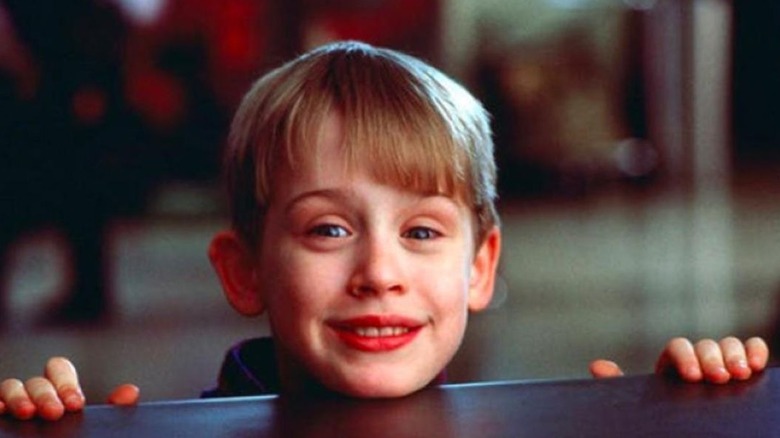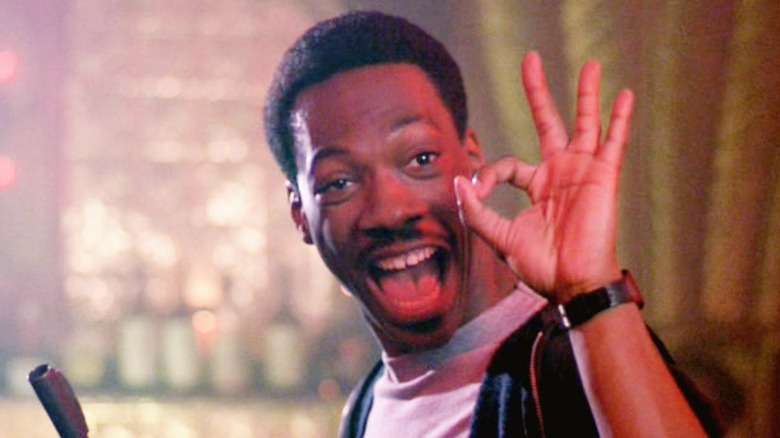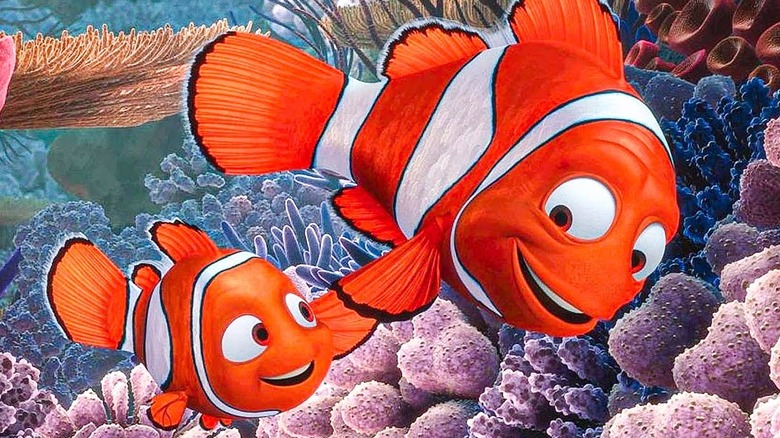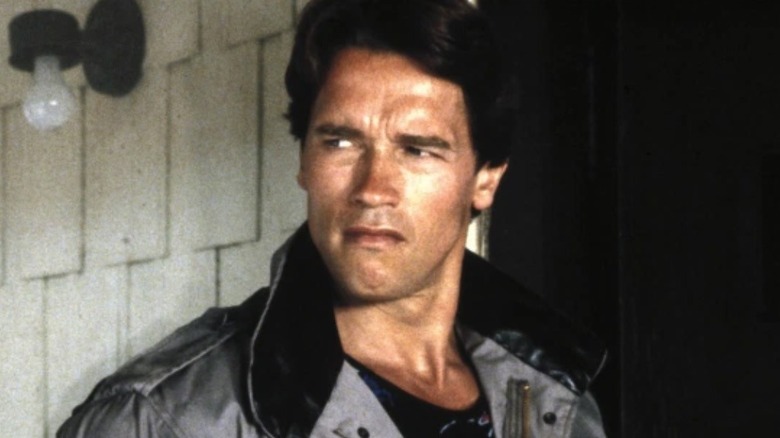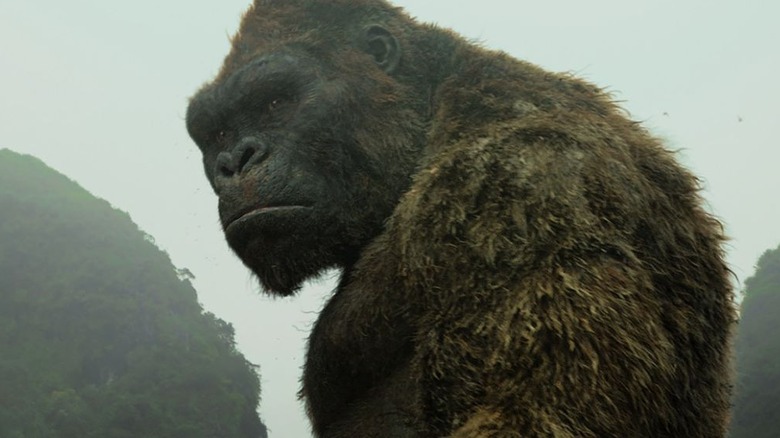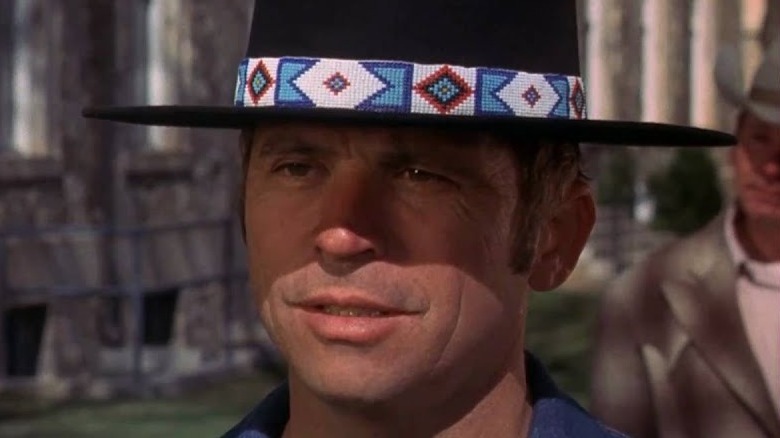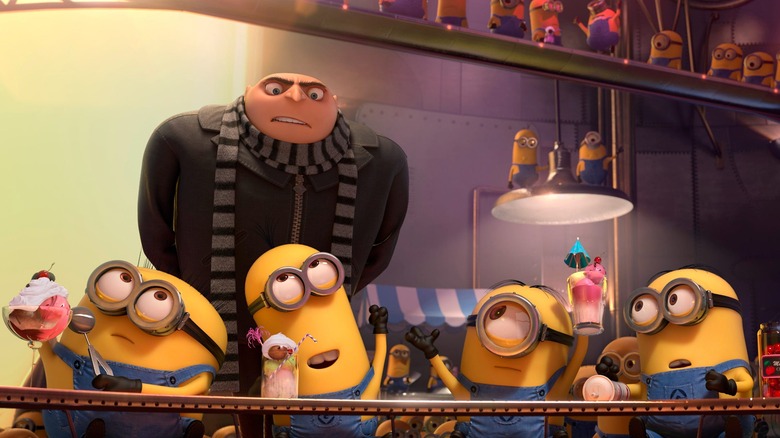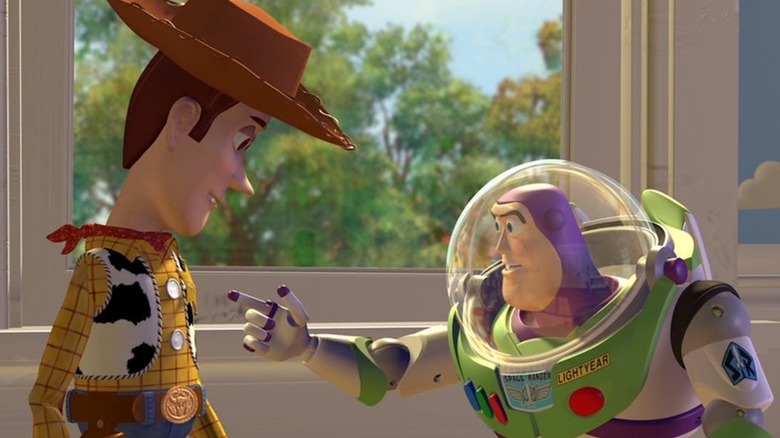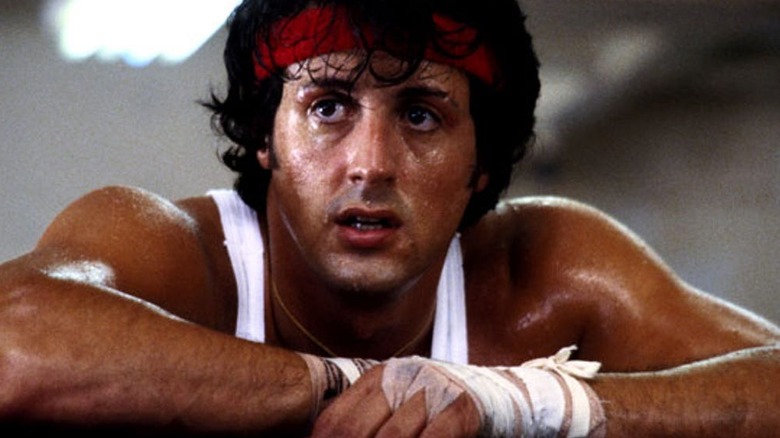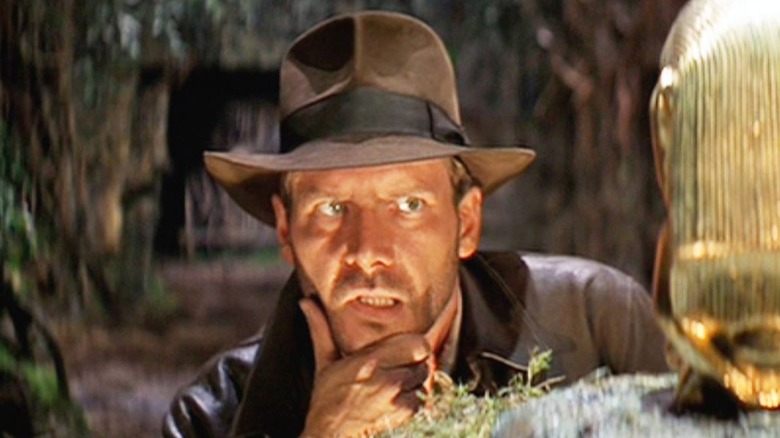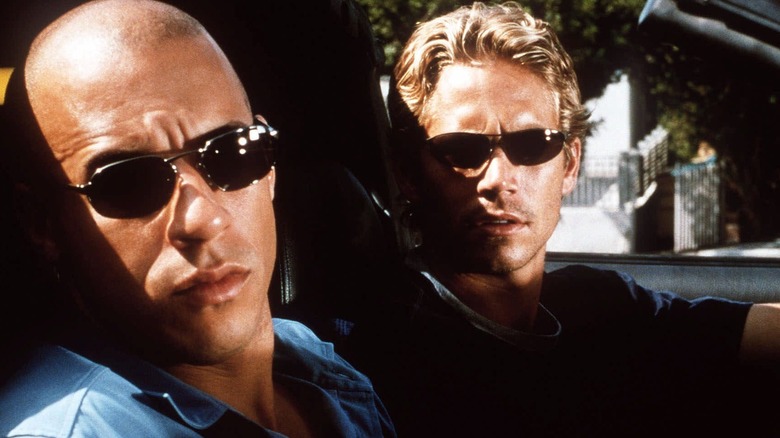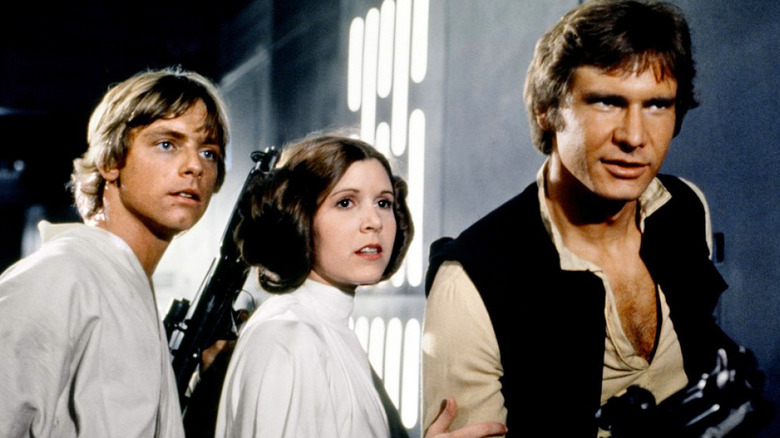Biggest Blockbuster Franchises Not Based On Anything
Moviegoers may say otherwise, but the truth is that original content is exploding right now, whether it's independent films, streaming content, or traditional TV — just not Hollywood big screen filmmaking. We live in the IP or Intellectual Property era, in which every blockbuster has to be a sequel, reboot or remake based on something with a built-in audience from another medium (movie, TV, book, cartoon, toy, ride, etc.). If you're going to spend $200 million on something, you want to make sure it's going to make its money back, right? Besides, we moviegoers haven't been great about showing up to original movies. Heck, for all the talk about Disney's dominance thanks to Marvel and Star Wars, some of the Mouse House's original live-action releases are among the biggest bombs of all time.
Movies aren't just "art for art's sake" — they're businesses that thousands of people depend on for their livelihoods. Why risk a "Tenet," when you can play it safe with "Godzilla vs. Kong?" However, some of the biggest hit franchises of all time started with original movies not based on anything. Not comics, books, TV shows, just a filmmaker's dream. We're going to rank these "cinema-first" franchises based on their inflation-adjusted domestic box office, as most came out before the current globalized IP era. Would they survive today? Would they even be made? If you've never read the book or seen the show these movies were based on, don't worry — there weren't any. Here are the biggest blockbuster franchises not based on anything!
13. Lethal Weapon
While we haven't seen Detectives Martin Riggs and Roger Murtaugh since 1998 — except for a short-lived (2016-2019) Fox series – "Lethal Weapon" was a box office powerhouse. "Lethal Weapon" started as a spec script by Shane Black, a 24-year-old aspiring writer fresh out of UCLA who was living in a bungalow in West L.A. when he wrote an "urban western" about an aging detective "too old for this s**t" and his suicidal super-soldier partner.
The mismatched buddy cop flick was cliché even in the 1980s, but thanks to Black's smart script, Richard Donner's dynamite direction, and especially Mel Gibson and Danny Glover's chemistry, "Lethal Weapon" earned $65 million domestic and $120 million worldwide on a $15 million budget. "Lethal Weapon 2" more than doubled that domestic gross, earning $147 million in 1989, while "Lethal Weapon 3" earned a slightly less, but still impressive, $144 million in 1992. All previous "Lethal Weapon" movies were made for less than $40 million, but "Lethal Weapon 4" had its budget boosted to $140 million, making its otherwise impressive $130 million domestic and $285 million worldwide take not very profitable. Still, with $487 million domestic — $1.065 billion when adjusted for inflation — the quintessential buddy cop flick was dominant in its day.
12. Home Alone
While John Hughes is best remembered for tales of teen angst, his biggest cultural footprint comes from "Home Alone," which he came up with while preparing for vacation: "I thought, 'Well, I'd better not forget my kids,'" he told Time magazine. "Then I thought, 'What if I left my 10-year-old son at home? What would he do?'" Hughes was super prodigious in this era, penning, producing, and/or directing 13 movies between 1982 and 1989, so he passed directorial duties to Chris Columbus. Despite Hughes' track record, Warner Brothers turned it down, while 20th Century Fox picked it up for a modest $15 million budget.
Talk about a good investment: "Home Alone" wasn't just the surprise sleeper holiday hit that plays as counter-programming to the big blockbusters — it was the big blockbuster. The movie's $285 million domestic and $476 million worldwide take made it 1990's biggest hit. Even though the $173 million domestic and $358 million worldwide gross of "Home Alone 2" was a big drop, it still made a ton of money on a $20 million budget. The same probably can't be said for the rest of the series, which was eventually relegated to the straight-to-DVD bin. However, based on the first two alone, the "Home Alone" franchise earned $490 million domestic, which adjusted for inflation is just over $1.065 billion.
11. Beverly Hills Cop
Dream of becoming a screenwriter? Prepare to have your script be totally different from the finished film. Case in point: "Beverly Hills Cop." Legend has it that in the 1970s then-Paramount president Michael Eisner came up with the idea of a movie about a Hollywood cop after getting pulled over. From this, screenwriter Danilo Bach wrote "Beverly Drive," about a Pittsburgh cop who investigates his buddy's death in Beverly Hills. That basic idea remained, but subsequent drafts from Bach and others lacked the "fish-out-of-water" aspect Eisner was after, until Daniel Petrie Jr. came aboard and inserted some humor.
Meanwhile, Sylvester Stallone came on board and rewrote the script to suit his strengths, but dropped out when his script was deemed too expensive (much of which wound up in "Cobra"), so Eddie Murphy was brought in two days later. Petrie rewrote the script again for Murphy, who wound up ad-libbing a lot of it anyway. "Beverly Hills Cop" made $234 million domestically and $316 million worldwide, topping the 1984 box office. "Beverly Hills Cop II" saw diminishing returns in 1987 ($153 million domestic and $276 million worldwide), while "Beverly Hills Cop III" barely broke even, earning $42 million domestically and $119 million worldwide on a $50 million budget. The three-film franchise earned $431 million domestically, for an inflation-adjusted total of $1.076 billion.
10. Finding Nemo
In a sea of sameness, Pixar stays afloat by producing (mostly) original stories. Of Pixar's 24 feature-length releases (including "Soul" and "Luca" on Disney+), 15 are original films, and none have been based on pre-existing material besides previous Pixar films. One of the studios' biggest successes is the "Finding Nemo" franchise, which began in Andrew Stanton's brain during a 1992 visit to Marine World. Cut to the late 1990s when Stanton prepared an elaborate pitch for Pixar's then-head honcho John Lasseter. After an exhaustive, hour-long presentation, Lasseter reportedly replied: "You had me at 'fish.'"
Production began in 2000 for a 2003 release. With nothing but Pixar's reputation behind it, "Finding Nemo" opened to $70 million, on its way to a $380 million domestic and $936 million worldwide box office gross. While four years is usually the maximum audiences will wait for a sequel, "Finding Dory" opened to $135 million 13 years later, earning $486 million domestically and $1.025 billion worldwide. With $867 million domestic in the (fish) tank, the "Finding Nemo" series' inflation-adjusted domestic gross is an incredible $1.077 billion.
9. The Terminator
James Cameron's movies make a lot of money. Heck, "Titanic" and "Avatar" might have made this list except they're not, you know, franchises (at least not yet). However, Cameron is also the mind behind one of the most famous action franchises of all time, "The Terminator." With one credit to his name in 1984, Cameron got a measly $6 million to film his original action/sci-fi/horror hybrid about a killer robot from the future with an Austrian accent.
"The Terminator came from a dream that I had while I was sick with a fever in a cheap pensione in Rome in 1981," Cameron told BFI. If only all of our bad dreams were so profitable. "The Terminator" became a sleeper hit when it earned $38 million domestically and $78 million worldwide. The series high water mark came with the second film, "Terminator 2: Judgment Day," which grossed $203 million domestically and $515 million worldwide, making it the biggest hit of 1991, a rare feat for an R-rated flick. The series has been hit or miss ever since, with the latest, "Terminator: Dark Fate," straight up bombing in 2019. But with a $669 million domestic total — $1.085 billion adjusted for inflation — we suspect the series will be back.
8. King Kong
"King Kong" is the only franchise on this list whose origins date back to Hollywood's golden age. The making of "King Kong" is a lengthy enough topic that has literally inspired entire books, but here's the Cliff Notes version: Filmmaker and adventurer Merian C. Cooper wanted to make a movie about a giant gorilla that fought dinosaurs. Thankfully for us he got his way. Cooper's wild idea connected with Depression-era audiences looking for escapism, and earned $10 million in 1933, a whopping $207 million when adjusted for inflation.
"Son of Kong" was rushed into theaters that same year with underwhelming results, so besides the bevy of "what ifs?", remakes and ripoffs, King Kong stayed on Skull Island for 40 years until Paramount's successful 1976 remake. Kong was put to bed again after a terrible 1985 sequel, "King Kong Lives," but the big ape returned to his blockbuster ways with Peter Jackson's 2005 remake and Kong's subsequent entry into the Monsterverse films, "Kong: Skull Island" and "Godzilla vs. Kong." Not including "Son of Kong," or the Toho-produced hits "King Kong vs. Godzilla" and "King Kong Escapes," the big ape boasts a domestic box office of $553 million over six films, which adjusted for inflation equals $1.2 billion.
7. Billy Jack
You may have never heard of "Billy Jack," but if you were going to movies in the 1970s you couldn't have missed him. Before there was John Rambo, there was Billy Jack, a half-Navajo ex-Green Beret and master of Hapkido, who first appeared in 1967's "The Born Losers." Billy Jack was the brainchild of husband-and-wife team Tom Laughlin and Delores Taylor. Laughlin also played the title role and directed the films under a pseudonym, T.C. Franks, presumably to not look like an egomaniac. He shouldn't have been so modest.
"The Born Losers" was a huge hit, earning $36 million domestically in 1967 ($290 million adjusted for inflation). Despite these numbers, Laughlin and Taylor had trouble securing financing for the 1971 sequel, "Billy Jack," and eventually paid to distribute it themselves. That worked out well; "Billy Jack" made $98 million, which is — wait for it — $651 million adjusted for inflation. What?! The 1974 sequel, "The Trial of Billy Jack," added another $89 million to the series' purse ($485 million when adjusted for inflation), but later entries "Billy Jack Goes To Washington" (1977) and the unfinished "The Return of Billy Jack" (1985) never received proper theatrical releases. Still, with just three films, the "Billy Jack" series earned $223 million domestically, which adjusted for inflation equals $1.254 billion dollars.
6. Despicable Me
Superheroes get all the publicity, but since the rise of Pixar and "Shrek" in the 1990s and 2000s, CG animation has been even more prevalent than spandex. Few animated series (CG or hand-drawn) have done as well as "Despicable Me," which is interesting because the main character isn't a cuddly lion or a talking car but an evil mastermind bent on world domination. Though it probably doesn't hurt that you see those "Minions" things everywhere.
While "Despicable Me" seems like a studio-mandated movie made to sell toys, it's actually the brainchild of animator Sergio Pablos, whose original pitch "Evil Me," was a last-gasp effort to save his dying animation studio. Chris Meledandri of Illumination Entertainment bought the story, which was reconfigured (Pablo joked: "I'm not to blame for the Minions") and eventually made into the hit Universal franchise we know today. With $1.22 billion in domestic earnings across four films, the "Despicable Me" series' adjusted for inflation gross is $1.34 billion. That's enough for Gru to retire forever from villainy.
5. Toy Story
The computer-animated era began with "Toy Story." Before Gru, Shrek, Po, or any CG character that has come since, there were Woody and Buzz Lightyear. The "Toy Story" tale goes all the way back to Pixar's pre-feature days, when the studio's short film "Tin Toy" won the Oscar for Best Animated Short in 1988. Using the momentum from that, Pixar pitched Disney on a live-action feature version, which went into production in 1991, giving you an idea of how long CG animation takes.
The scale of this project could not be underestimated. There had been CG shots and CG characters ... but an entire feature-length film? That was unheard of. Fortunately, the bet paid off and "Toy Story" didn't just do well; its $192 million domestic box office topped all for 1995. Besides launching its own four-film franchise, "Toy Story" ushered in a new era in animation, which Pixar's then-owner Steve Jobs predicted. Also impressive is how the series has continued to connect with fans of all ages for over 25 years, despite lengthy gaps between films. The "Toy Story" series has put $1.3 billion in its domestic toy chest, for an inflation-adjusted North American gross of $1.79 billion.
4. Rocky
The making of "Rocky" is one of the most well-known Hollywood stories of all time: Struggling, down-on-his-luck actor Sylvester Stallone writes a script about a struggling, down-on-his-luck boxer who goes the distance against the heavyweight champ of the world. Stallone was offered big bucks for the script, but refused to sell unless he could star. It was a risky bet that paid off. That movie, "Rocky," went on to win the Academy Award for Best Picture in 1977 and grossed $117 million domestically, the most of any movie released in 1976.
The "Rocky" franchise went from underdog to undisputed champ, launching eight films and two separate series over the past five decades and counting. The series peak came in 1985 with "Rocky IV," which earned $127 million domestically and $300 million worldwide as Rocky also won the Cold War. All of the movies have ranged from modest hits (yes, even "Rocky V") to outright blockbusters, and the series has earned $792 million domestically, for an inflation-adjusted gross of $1.95 billion. Not bad for a boxer looking for his big break.
3. Indiana Jones
Some say academia isn't very lucrative, but nobody told that to Dr. Henry Jones, Jr., a.k.a. Indiana Jones. Of course, globetrotting and treasure hunting pays the bills, and the intrepid archaeologist is the highest-earning individual character on this list. No complicated mythologies. No massive ensembles. Just a fedora, a bullwhip, and Harrison Ford is all this series needs. In the late 1970s, Steven Spielberg was rejected twice for his dream job of directing a James Bond movie, the first time after "Jaws," because he wasn't deemed right for the assignment, and the second time after "Close Encounters of the Third Kind," when the producers thought he'd be too expensive. So legend has it his old buddy George Lucas brought Spielberg in to direct his big idea, an American answer to James Bond named Indiana ... Smith.
Thankfully, they changed the name, though studios balked at the $20 million price tag and, shockingly, Spielberg as director, since he'd just had a huge bomb with "1941." Lucas stuck with Spielberg and they finally found a buyer in Paramount. It worked out pretty well for all parties. "Raiders of the Lost Ark" earned $225 million, topping the year-end box office and bringing Spielberg back to his winning ways. The Indy trio of Spielberg, Lucas, and Ford would return for three more films over the next 24 years, resulting in total domestic earnings of $919 million. That's impressive on its own, but when adjusted for inflation it's downright staggering — $2.074 billion.
2. The Fast Saga
What makes a multi-billion-dollar hit franchise? Family ... and fast cars ... and explosions. Lots of explosions. The transition of "The Fast Saga" from a drama about East L.A. street racers into a mega-blockbuster series about international super spies has been about as smooth as driving a Pontiac Fiero through space. However, the results have certainly been lucrative. "The Fast and the Furious" was basically an early 2000s remake of "Point Break," but with muscle cars instead of surfboards, which was enough to earn $144 million domestically and $206 million worldwide on a $38 million budget.
We won't get into the convoluted behind-the-scene shenanigans or the even-more-convoluted onscreen continuity, only to say the series switched gears more times than Vin Diesel's Dominic Toretto chasing a terrorist. The big gear shift came during the fourth film in 2009, "Fast and Furious," which got the series back to its winning ways and saved the franchise from extinction. Since then, "The Fast Saga" has gone on a mostly upward trajectory, due in no small part to the addition of Dwayne Johnson's fan favorite Agent Hobbs character in "Fast Five." Across 11 films over 21 years, including 2019 spinoff "Hobbs and Shaw," "The Fast Saga" has revved up $1.773 billion domestically, for an inflation-adjusted total of $2.086 billion. That'll buy you a lot of sports cars.
1. Star Wars
Come on, were you expecting anything different? Given the number of sequels, spin-offs, cartoons, novelizations, and merchandise that the "Star Wars" series has spawned, it may be easy to forget it all started in George Lucas' brain. Arguably the most popular movie franchise of all time (the MCU has made more money, but "Star Wars" has a higher domestic average) and definitely the most popular cinema-first series of all time, "Star Wars" combined Lucas' diverse genre diet into one story.
From Flash Gordon serials to John Ford's Westerns, from Akira Kurosawa samurai films to Joseph Campbell's mythology, "Star Wars" blends all of George Lucas' pop culture upbringing into a space opera that is even more ubiquitous and popular today than it was 44 years ago. And make no mistake, it was really popular 44 years ago. "Star Wars" grossed $460 million in 1977, which would be a huge hit today, but adjusted for inflation would be more than $2 billion! Pardon the pun, but that's out of this world, and makes "Star Wars" the second biggest ticket seller ever – a feat unlikely to be topped. Five decades and 11 films later, the series is still blasting into warp speed. With a total domestic box office of more than $5 billion, the "Star Wars" franchise has made $8.08 billion when adjusted for inflation (more than $6 billion more than the second series on this list, "The Fast Saga"), making it far and away the biggest blockbuster franchise not based on anything.
